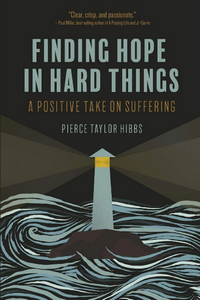 |
Finding Hope in Hard Things:
|

We think we’re stone. Only chisels and hammer strikes can change our shape. But no; we’re wet clay. We’re sediment and soil. We’re waiting for hands. We’re waiting for fingertips. We’re waiting for the pressure of palms. We’re waiting to be shaped by an artist. And the artist’s tools are hard things.
Hard Things are Going to Shape Us in Ways Easy Things Can’t
That’s it, there’s the book in a nutshell—that line and the quotation, there’s the central premise of the book and the kind of way he presents it.
Hibbs focuses on three of the hard things he’s faced in his life—the death of his father, his anxiety disorder, and his struggles with self-doubt. These case studies are just that, things that his readers can relate to, sympathize with, and find similarities in their lives. After that, Hibbs points to finding Christ and His purposes in the hard things, and that’s where we find hope.
Anxiety disorders, Crohn’s disease, cancer of the spine, the death of your father—these things happen. What matters most is not what happens to you but how you perceive and respond to it. Perception and response—that’s the key.
So, what did I think about Finding Hope in Hard Things?
I’ve talked about two of Hibbs’s books here before—Finding God in the Ordinary and Struck Down but Not Destroyed: Living Faithfully with Anxiety. The former is a collection of essays about finding God in ordinary, minute things in life; the latter is a thoughtful and thorough look at how Hibbs has dealt with his Anxiety Disorder, and how the reader can apply these things to their own problems. This book combines the best of the two approaches to these books—we don’t get a systematic look at suffering. Instead, we get essays based on his studies, based on his observations and thoughts.
I loved this approach, this style. Most books on suffering that I’ve read are meditations or studies on the relevant Psalms—maybe a passage or two from the Gospels or Epistles. Hibbs doesn’t do that, he talks about where he is, where he’s been, where his readers are/have been/will be. He’s learned the lessons of those other books and now he’s internalized them. He can meditate, muse, and reflect—and that’s what these essays are.
As with his earlier book, these essays are wonderfully put together, a pleasure to read, even without the content.
On an episode of The West Wing, Leo McGarry tells a story:
“This guy’s walking down the street when he falls in a hole. The walls are so steep he can’t get out.
“A doctor passes by and the guy shouts up, ‘Hey you. Can you help me out?’ The doctor writes a prescription, throws it down in the hole and moves on.
“Then a priest comes along and the guy shouts up, ‘Father, I’m down in this hole can you help me out?’ The priest writes out a prayer, throws it down in the hole and moves on.
“Then a friend walks by, ‘Hey, Joe, it’s me can you help me out?’ And the friend jumps in the hole. Our guy says, ‘Are you stupid? Now we’re both down here.’ The friend says, ‘Yeah, but I’ve been down here before and I know the way out.'”
I thought about that story a lot while reading this. Hibbs is that friend. He knows the way out of the hole—better yet, he understands why the hole is there and how it’s used by God to make us into who He wants.
This isn’t your typical book on suffering, it’s better.

This post contains an affiliate link. If you purchase from it, I will get a small commission at no additional cost to you. As always, opinions are my own.
![]()



Evidence Mutumbu
Im tempeted to read this book.